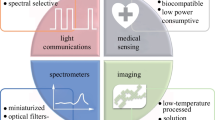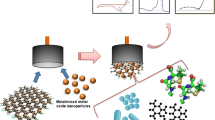Abstract
Macroporous silicon (pore diameter 1–2 μm) was used in an electrical sensor for real time, label free detection of DNA hybridization. Electrical contacts were made exclusively on the back side of the substrate, which allowed complete exposure of the porous layer to DNA. Hybridization of a DNA probe with its complementary sequence produced a reduction in the impedance and a shift in the phase angle resulting from a change in dielectric constant inside the porous matrix and a modification of the depletion layer width in the crystalline silicon structure. The effect of the DNA charge on the response was corroborated using peptide nucleic acid (PNA), an uncharged analog of DNA. The sensitivity and selectivity of the device were characterized and the sensing properties of the porous layer alone were investigated using self-supporting macroporous silicon membranes.
Similar content being viewed by others
References
M. Archer, M. Christophersen, P.M. Fauchet, D. Persaud, and K.D. Hirschman, Mat. Res. Soc. Symp. Proc. Vol. 782, A7.2.1–A7.2.7 (2004b).
M. Archer, M. Christophersen, and P.M. Fauchet. Accepted for publication in Sensors and Activators (2004).
M. Archer and P.M. Fauchet, Physica Status Solidi A 198, 503 (2003).
H. Bemey, J. West, E. Haefele, J. Alderman, W. Lane, and J.K. Collins, Sensors and Actuators B 68, 100 (2000).
Y.C. Cao, R. Jin, and C.A. Mirkin, Science 297, 1536 (2002).
S. Chan, S. Homer, P.M. Faucher, and B.L. Miller, Journal of the American Chemical Society 123, 11797 (2001).
J.P. Cloarec, J.R. Martin, C. Ploychronakos, I. Lawrence, M.F. Lawrence, and E. Souteyrand, Sensors and Actuators B 58, 394 (1999).
Y. Cui, Q. Wei, H. Park, and C.M. Lieber, Science 293, 1289 (2001).
K.-P.S. Dancil, D.P. Greiner, and M.J. Sailor, Journal of the American Chemical Society 121, 7925 (1999).
X. Fang, X. Liu, S. Schuster, and W. Tan, Journal of the American Chemical Society 121, 2921 (1999).
H. Foell, M. Christophersen, J. Carstensen, and G. Hasse, Materials Science and Engineering R R39, 93 (2002).
J. Fritz, E.B. Cooper, S. Gaudet, P.K. Sorger, and S.R. Manalis, Proceedings of the National Academy of Sciences U.S.A. 99, 14142 (2002).
J. Hahm and C.M. Lieber, Nano Letters 4, 51 (2004).
J. Hirabayashi, Trends in Biotechnology 21, 141 (2003).
J. Homola, S.S. Yee, and G. Gauglitz, Sensors and Actuators B 54, 3 (1999).
A. Janshoff, K.-P.S. Dancil, C. Steinem, D.P. Greiner, V. Lin, C. Gurmer, K. Motesharei, M.J. Sailor, and M.R. Ghadiri, Journal of the American Chemical Society 120, 12108 (1998).
I. Manelli, M. Minunni, S. Tombelli, and M. Mascini, Biosensors and Bioelectronics 18, 129 (2003).
F. Moeller, M. Ben-Chorin, and F. Koch, in Solid Films 55, 16 (1995).
H.H. Okom-Schmidt, IBM Journal of Research and Development 43, 351 (1999).
E. Palecek and F. Jelen, Critical Reviews in Analytical Chemistry 32, 261 (2002).
A.W. Peterson, L.K. Wolf, and R.M. Georgiadis, Journal of the American Chemical Society 293, 14601 (2002).
A.W. Peterson, R.J. Heaton, and R.M. Georgiadis, Nucleic Acids Research 29, 5163 (2001).
R. Raiteri, M. Grattarola, H.-J. Butt, and P. Skladal, Sensors and Actuators B 79, 115 (2001).
A. Simonis, C. Ruge, M. Mueller-Veggian, H. Lueth, and M.J. Schoening, Sensors and Actuators B 91, 21 (2003).
E. Souteyrand, J.P. Cloarec, J.R. Martin, C. Wilson, I. Lawrence, S. Mikkelsen, and M.F. Lawrence, Journal of Physical Chemistry B 101, 2980 (1997).
M. Stewart and J. Buriak, Advanced Materials 12, 859 (2000).
J. Wang, Nucleic Acids Research 28, 3011 (2000).
J. Wang, Chemistry-A European Journal 5, 1681 (1999).
J. Wang and A.J. Bard, Analytical Chemistry 73, 2207 (2001).
J. Wang, E. Palecek, P.E. Nielsen, G. Rivas, X. Cai, H. Shiraishi, N. Dontha, D. Luo, and P.A.M. Farias, Journal of the American Chemical Society 118, 757 (1996).
S.B. Weisman and T. D Singer, Biotechnolgy Advances 20, 379 (2002).
Author information
Authors and Affiliations
Rights and permissions
About this article
Cite this article
Archer, M., Christophersen, M. & Fauchet, P. Macroporous Silicon Electrical Sensor for DNA Hybridization Detection. Biomedical Microdevices 6, 203–211 (2004). https://doi.org/10.1023/B:BMMD.0000042049.85425.af
Issue Date:
DOI: https://doi.org/10.1023/B:BMMD.0000042049.85425.af




